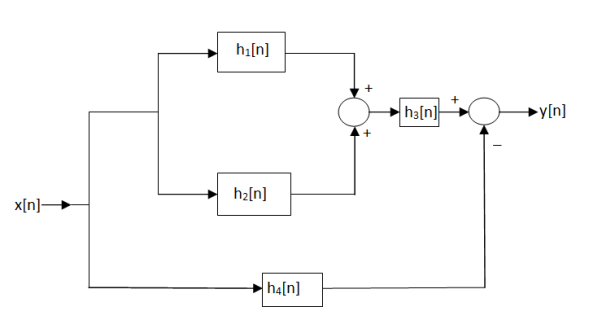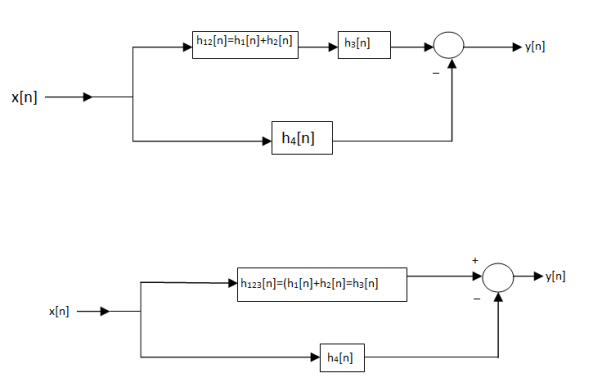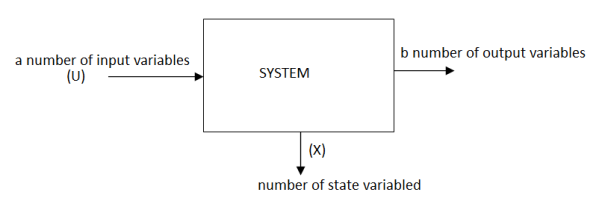Unit - 2
Behaviour of continuous and discrete time LTI systems
Q1) Explain impulse response and step response?
A1) If the input to the system is unit impulse response, then the output of the system is known as impulse response of the system denoted by h(n). That is
h(n) = T [ δ(n)]…………………………………………………………..(1)
The arbitrary sequence x(n) can be represented as weighted sum of discrete impulses given by
x(n) =  δ(n-k) --------------------------------------------(2)
δ(n-k) --------------------------------------------(2)
Then the output
y(n) = T [  δ(n-k)] -----------------------------------------------------(3)
δ(n-k)] -----------------------------------------------------(3)

Figure. Step response
The step response of a discrete-time LTI system is the convolution of the unit step with the impulse response-
s[n]=u[n]*h[n]. -------------------(1)
Commutative property of convolution,
s[n]=h[n]*u[n]. ----------------------------------------(2)
That means s[n] is the response to the input h[n] of a discrete-time LTI system with unit impulse response u[n].

Figure. LTI discrete time
s[n] =  u[n-k] ------------------------------------(1)
u[n-k] ------------------------------------(1)
Since u [n- k]< 0 is for n- k< 0, i.e. k> n and 1 for n -k> 0, i.e. k≤ n.
Therefore,  -----------------------------------------------(2)
-----------------------------------------------(2)
That is the step response of the discrete LTI system is the running sum of its impulse response.
s[n-1] = 
s[n] – s[n-1] =  -
- 
h[n] = s[n] – s[n-1]
From here h[n] can be recovered from s[n] , the impulse response of discrete-time LTI system is the first difference of its step response.
For continuous time system
The unit step response is the running integral of its impulse response.
s(t) =  ) dτ
) dτ
The unit impulse response is the first derivative of the unit step response: -
h(t) = ds(t)/dt = s’(t)
Q2) Write a short note on Convolution?
A2) The input signal to the system is x(n) and the output is y(n).

Figure. I/O relation
If the input to the system is unit impulse then the output of the system is known as impulse response of the system denoted by h(n).
h(n) = T [ ∂(n)]
The arbitrary sequence x(n) can be represented aa a weighted sum of discrete impulses given by
x(n) =  ∂(n-k)
∂(n-k)
Then the output
y(n) = T [  ∂(n-k)]
∂(n-k)]
Using linear property of the system, interchange the system operator T with the summation x(k) to obtain
y(n) =  T [ ∂(n-k)]
T [ ∂(n-k)]
Now
y(n) =  h(n,k)
h(n,k)
For a time-invariant system
h(n,k) = h(n-k)
Therefore
y(n) =  h(n-k)
h(n-k)
Thus, the output of the LTI system is given by the weighted sum of the time-shifted responses.
This sum is termed as convolution sum represented as
y(n) = x(n) * h(n) where * denotes convolution.
Q3) Explain cascade connections?
A3) Consider the cascade connection of two LTI systems, as illustrated in Fig. (a). Let z(t) be the output of the first system and therefore the input to the second system in the cascade.
The output is expressed in terms of z(t) as 𝑦 (𝑡) = 𝑧(𝑡) ∗ ℎ2(𝑡)
Substituting for z(t), we get
y(t) =  h2(t-τ) dτ
h2(t-τ) dτ
Putting for z(t) we get
y(t) =  h1(τ-v) h2(t-τ) dv dτ
h1(τ-v) h2(t-τ) dv dτ
=  h(t-τ) dv
h(t-τ) dv
= h(t) * h(t)

Figure. Cascade connection
Interconnection of two LTI systems. (a) Cascade connection of two systems. (b) Equivalent system. (c) Equivalent system: Interchange system order.
Problem:
Consider the interconnection of four LTI systems as shown in figure. The impulse responses of the systems are
h1[n] = u[n]
h2[n] = u[n+2] – u[n]
h3[n] = δ[n-2]
And
h4[n] = α n u[n]
Find the impulse response h[n] of the overall system.

Figure. Impulse response h[n]
We first derive the expression for the overall impulse response in the terms of impulse response of each system.
The parallel com0bination h1[n] and h2[n] . The distributive property implies that the equivalent system h12[n] = h1[n] + h2[n] as shown in figure 1.

Fig. Reduction
This system is in series with h3[n] so the associative property implies that the equivalent system for the upper branch has the impulse response h123[n] = h12[n] * h3[n]
Substituting for h12[n] in this expression we have
h123[n] = (h1[n] + h2[n] * h3[n]) as shown in fig(b) . Last the upper branch is in parallel with the lower branch characterized by h4[n] ; hence application of the distributive property gives the overall system impuse response as h[n] = h123[n] – h4[n]
Substituing for h123[n] in this expression yields
H[n] = ( h1[n] + h2[n] ) * h3[n] – h4[n]
As shown in fig ( c)
Now substitute the specified forms h1[n] and h2[n] to obtain
h12[n] = u[n] + u[n+2] – u[n]
=u[n+2]
Convolving h12[n] with h3[n] gives
h123[n] = u[n+2] * δ[n-2] = u[n]
Finally, we sum h123[n] and -h4[n] to obtain the overall impulse response
h[n] = { 1- α n } u{n}

Fig. Output response
Q4) Explain stability of LTI system?
A4) Stability:
A system is said to be stable if a bounded input sequence produces bounded output sequence. For bounded input sequence x(n) if the output is unbounded the system is said to be unstable system.
Let x(n) be a bounded input sequence satisfying |x(n) | ≤ Mx < ∞. Let h(n) be the impulse response of the system then the output y(n) can be found by convolution sum . That is
y(n) =  h(n-k) = =
h(n-k) = =  x(n-k)----------------------(1)
x(n-k)----------------------(1)
The magnitude of the output is given by
|y(n)| = |  x(n-k)|-------------------------(2)
x(n-k)|-------------------------(2)
We know that the magnitude of the sum of terms is less than or equal to the sum of the magnitudes, hence
|y(n)| = |  x(n-k)|≤
x(n-k)|≤  || x(n-k)| --------------------(3)
|| x(n-k)| --------------------(3)
Let the bounded value of the input be equal to M then eq(3) can be written as
|y(n) | ≤ M  |------------------------------(4)
|------------------------------(4)
The above condition is satisfied when
 | < ∞ ------------------------(5)
| < ∞ ------------------------(5)
Therefore, the necessary and sufficient condition for stability is
 | < ∞ -----------------------(6)
| < ∞ -----------------------(6)
Therefore, the LTI system is stable if its impulse response is absolutely summable.
Q5) Explain causality of LTI system?
A5) If x(t) = ∂(t) then according to convolution theorem
y(t) = x(t) * h(t) = h(t) * ∂(t) = h(t)
A casual system is one where the output at the present instant does not anticipate input from future instants.
X(t) , t<to ------- y(t) , t<to
An LTI system is casual if and only if
h(t) = L (δ(t)) = 0 , t<0
The impulse response of the system has to be zero for negative time for the system to be casual.
For discrete time system the impulse response of the sequence h[n] of LTI system has to be right -sided sequence
h[n] = L (δ[n]) = 0 , n<0
Q6) Explain the system representation for differential equation?
A6) An LTI system is specified by equation
d 2 y(t)/ dt 2 + 5 d y(t) /dt + 6 y(t) = dx(t) / dt + 4 x(t)
The input is x(t) = e -t u(t)
Find the natural response for initial conditions:
y (0+) = 3 d y(0+)/dt =0
Forced response
Total response
Given d 2 y(t) / dt 2 + 5 d y(t)/dt + 6 y(t) = d x(t)/dt + 4 x(t)
The natural response can be obtained by equating input terms in differential equation to zero.
d 2 y(t) / dt 2 + 5 d y(t)/dt + 6 y(t)=0
The characteristic equation is
- 2 + 5
 + 6=0
+ 6=0
- 1=-2 and
 2 = -3
2 = -3
The homogenous solution is
Yh(t) = c1 e -2t + c2 e -3t
y (0+) = c1 + c2
d y (0+)/dt = 2 c1 e -2t + (-3) c2 e -3t |t=0
= 2c1 – 3c2
From initial conditions
y (0+) = 3
Dy (0+)/dt =0
Comparing we get c1 + c2 =3
2c1 + 3c2 =0.
c2 =-6 and c1=9
Yn(t) = 9 e -2t – 6 e -3t
Forced response:
The homogeneous solution is given by
Yn(t) = c1 e -2t + c2 e -3t
For input x(t) = e -t
The particular solution is of the form
Yp(t) = k e -t
From which
Dyp(t)/dt = -k e-t
d2 yp(t)/dt2 = k e-t
Therefore,
d 2 yp(t)/dt2 + 5 d yp(t)/dt + 6 yp(t) = dx(t)/dt + 4 x(t)
k e -t – 5 k e-t + 6 k e-t = - e-t + 4 e-t
2k = 3
K=1.5
Yp(t) = 1.5 e -t.
The forced response is the sum of homogeneous solution for particular solution.
Yf(t) = c1 e -2t + c2 e -3t + 1.5 e -t
y(0+) = c1 + c2 +1.5
Dy(0+)/dt = -2c1 e -2t -3 c2 e -3t – 1.5 e -t |t=0
To obtain forced response equate initial conditions to zero
C1 + C2 = -1.5
2C1 + 3C2 = -1.5
Solving for c1 and c2 we get
C2 = 1.5
C1 =-3
y(t) = yn(t) + yf(t)
Substituting yn(t) and yf(t) we get
y(t) = 6 e -2t – 4.5 e -3t + 1.5 e -t
y(0) = c1 + c2 + 1.5 =3
Dy(0+)/dt = -2c1 -3c2 -1.5 =0
c1 =6 and c2 =-4.5
y(t) = 6 e -2t -4.5 e -3t + 1.5 e -t
Q7) Explain the state space representation of the system?
A7) For LTI system with output signal y(t) with input signal u(t) and impulse response h(t).
Therefore, y(t) = h(t) * u(t) -> Y(s) = H(s) U(s)
This representation of the system expresses the input output relation. It does not provide us the internal specification of the system.
State space representation not only provide information on I/O but also gives good view on the internal specification of the system.
The states of the system at time to includes min required information to express the system situation at time to. These are the first- degree equations.
State space representation of LTI system is given by
 = AX(t) + B U(t) ------ state equations
= AX(t) + B U(t) ------ state equations
Y(t) = CX(t) + DU(t) --------- output equations
X  R n : state vector
R n : state vector
U  R m : input vector
R m : input vector
Y  R p : output vector
R p : output vector
A nxn : System Matrix
B nxm : Input matrix
C pxn : Output matrix
D pxm : Coupling matrix
Number of states usually equals to degree of the system.
Set of states in not unique for the system.

Fig. State Space Representation
Q8) Explain multiple input output representation?
A8) The state model of a linear, time-invariant MIMO system is a special case of the general time-invariant state model of Equations. In state representation, the derivative of each state variable can be written as a linear combination of system states and inputs i.e.
 = a11 x1(t) + a12 x2(t) + ……….+ a1n xn(t) + b11 u1(t) + b12 u2(t) +….+ b1m um(t) -----------------------------------(1)
= a11 x1(t) + a12 x2(t) + ……….+ a1n xn(t) + b11 u1(t) + b12 u2(t) +….+ b1m um(t) -----------------------------------(1)
 = a21 x1(t) + a22 x2(t) + ……….+ a2n xn(t) + b21 u1(t) + b22 u2(t) +….+ b2m um(t) -----------------------------------(2)
= a21 x1(t) + a22 x2(t) + ……….+ a2n xn(t) + b21 u1(t) + b22 u2(t) +….+ b2m um(t) -----------------------------------(2)
…….
 = an1 x1(t) + an2 x2(t) + ……….+ ann xn(t) + bn1 u1(t) + bn2 u2(t) +….+ bnm um(t) -----------------------------------(3)
= an1 x1(t) + an2 x2(t) + ……….+ ann xn(t) + bn1 u1(t) + bn2 u2(t) +….+ bnm um(t) -----------------------------------(3)
 = A x(t) + B u(t) ------ State Equation
= A x(t) + B u(t) ------ State Equation

 System Matrix
System Matrix
 Input Matrix
Input Matrix
Similarly the output variables can be written as a linear combination of system states and inputs that is
y1(t) = c11 x1(t) + c12 x2(t) +……..+ c1n xn(t) +d11 u1(t) + d12 u2(t) + …+ d1mum(t) ---------------------------------------(1)
y2(t) = c21 x1(t) + c22 x2(t) +……..+ c2n xn(t) +d21 u1(t) + d22 u2(t) + …+ d2mum(t)--------------------------------------------(2)
------
Yp(t)= cp1x1(t) + cp2x2(t) + ………..+ cpnxn(t) + dp1u1(t) + dp2u2(t) +….+dpmum(t)
Where coeffecients cij = i=1,2,p; j=1,2,p: k=1,2,m are constants.
In vector form
y(t)= Cx(t) + D u(t) ---------Output Equation.
Q9) Explain state transition matrix and its role?
A9) The state transition matrix is important part of both the zero input and the zero state solutions of systems represented in state space. The state transition matrix in the Laplace Domain, Φ(s), is defined as:

Where I is the identity matrix. The time domain state transition matrix, φ(t), is simply the inverse Laplace Transform of Φ(s).
Q10) Explain the notion of frequency response and its relation to impulse response?
A10) The output given by the convolution sum is
y(n) =  x (n-m) --------------------------(1)
x (n-m) --------------------------(1)
Suppose that the input is a complex exponential function, where for all n ∈ Integers, then
x(n) = e jwn ----------------------------------(2)
Then
y(n)=  ejw(n-m) -----------(3)
ejw(n-m) -----------(3)
= e jwn  e-jwm -------(4)
e-jwm -------(4)
When the input is the complex exponential with frequency ω , then the output is given by
y(n) = H(w) e jwn -----------------------(5)
Where H(ω ) is called the frequency response.
Comparing these two expressions for the output we see that the frequency response is related to the impulse response by
H(w) =  eimw -----------(6)
eimw -----------(6)
H(ω ) is called the discrete-time Fourier transform (DTFT) of h(n).